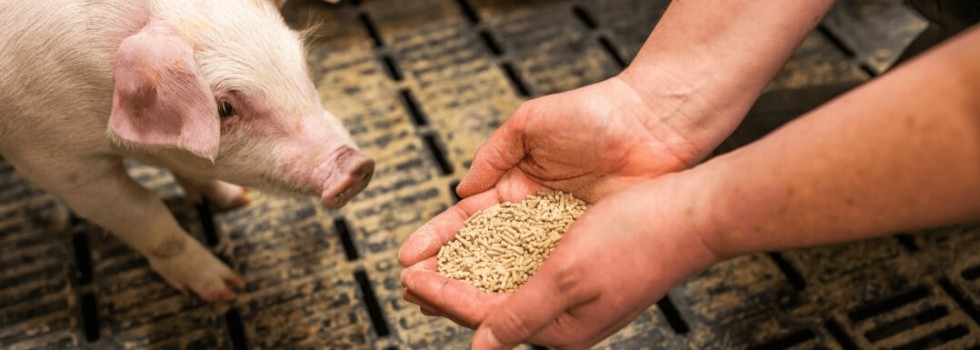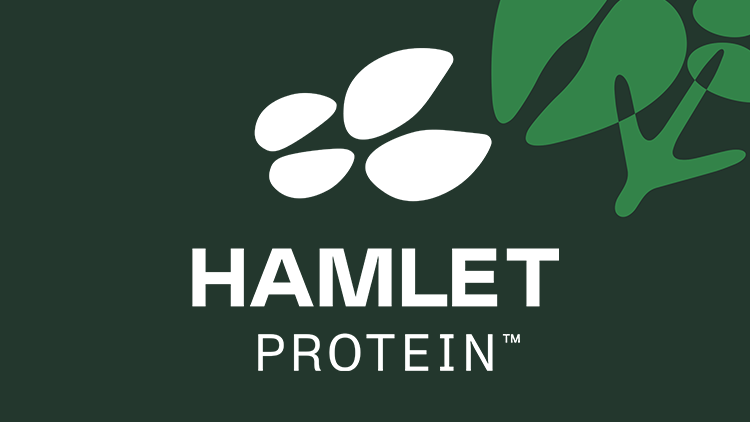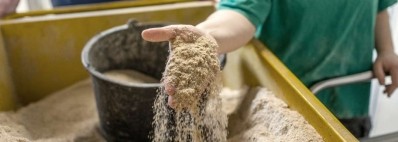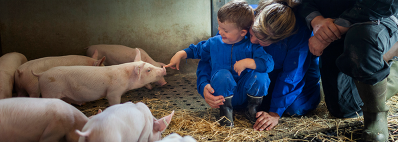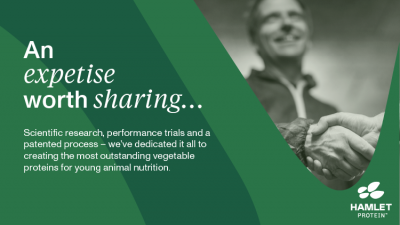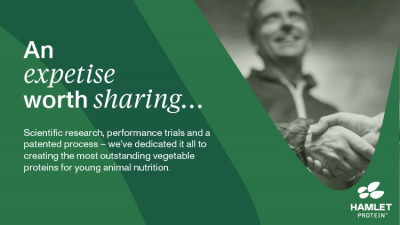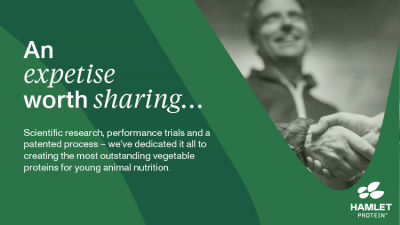Promotional Features
Improving growth and performance of weaned piglets using protein kinetics
Nursery diets of the near future can be formulated to optimize protein utilization, which is partly dependent on digestibility, but is largely influenced by the speed of protein digestion and absorption.
These so-called protein kinetics influence growth performance, reduce feed costs and mitigate the negative impact of undigested protein on piglets wellbeing and nitrogen excretion into the environment. Hamlet Protein has spent the last two years investigating how differences in protein kinetics affect its customers’ performance. This has led to new insights regarding suitable protein sources for nursery pig diets.
The results of this research have been published at a 2023 ASAS-CSAS-WSASAS meeting in the US and showed there are large differences in protein kinetics between protein sources.1 The faster a protein is hydrolyzed and absorbed, the greater it will be used for tissue deposition. This improves growth performance of the piglets and reduces the risk of protein fermentation by pathogens which can lead to diarrhea. Additionally, it contributes to a reduction of nitrogen into the environment.
What is protein kinetics all about?
The science of kinetics involves the degradation and absorption of nutrients. For protein kinetics it refers exclusively to the dynamics of protein hydrolysis and absorption. In other words, how fast and where in the digestive tract protein is digested and absorbed. Both the speed and the location of absorption influence the subsequent availability of amino acids.
Traditionally a protein ingredient is evaluated based upon its protein content (CP) and digestibility coefficient. The digestibility coefficient only considers how much protein is left at the end of the small intestine and does not say anything about digestion, absorption speed and location. Two protein sources can have similar digestibility but may differ largely in the speed and site of digestion and absorption (Figure 1).
Consider for instance blood meal and high protein soybean meal (SBM-HP) which both have a digestibility coefficient at the end of the small intestine (after which no protein absorption occurs anymore) of around 0.76. For blood meal, however, a lot more protein is hydrolyzed already in the first part of the small intestine while for SBM-HP more is hydrolyzed in more distal parts of the small intestine, which means that the digestion speed of protein from blood meal is higher than that from SBM-HP.
Figure 1: Apparent digestibility coefficients of blood meal and SBM-HCP (adapted from Toghyani et al., 20202).
Speed is the name of the game
The digestion speed is important because the first part of the small intestine (the jejunum) is more efficient in absorbing amino acids than the second part (the ileum). In the jejunum the intestinal cells that absorb the amino acids get most of their energy from glucose while in the ileum the intestinal cells use amino acids as well as an energy source resulting in more nitrogen excretion via urine and less protein deposition for an amino acid that is absorbed in the second part of the small intestine.
So, the faster a protein is hydrolyzed the more of the protein will be used for protein deposition.
It is now known that fast absorbable protein ingredients improve nitrogen (N) retention (protein efficiency) and feed efficiency of the animals. The rate of protein hydrolysis, the rate of amino acid (AA) absorption and the synchronization with AA from other protein sources are especially important in young animals, due to their high AA requirements for the synthesis of muscle tissue and vital organs. Therefore, protein kinetics are more indicative of feed efficiency and protein deposition than the digestibility coefficient of the protein ingredient.
Considering protein kinetics in diet formulation
In feed formulation, digestibility and energy content are used as fixed values of feed ingredients to optimize diets. This is quite practical but does not count in effects like differences in absorption speed and/ or interactions between different ingredients before and after absorption. A faster protein source becomes available faster for the pig, but a synchronization with AA absorption from other protein sources is needed to ensure optimal protein deposition. So, protein kinetics are especially important in diets that include low CP content combined with synthetic amino acids.
Hamlet Protein has tested the kinetics of a variety of protein sources. Results of these studies revealed that from all vegetal protein sources Hamlet Protein products have the fastest protein kinetics (see figure 2).
Figure 2: Speed of protein degradation as measured by the hydrolysis constant k[µL/(mole*s); µL=microliter NaOH needed to keep pH at 8 during hydrolysis (acid is released) and s=seconds] for 7 different soy-based protein ingredients when incubated with proteolytic enzymes for 120 minutes. Values in bubbles indicate the percentage difference to Hamlet Protein The higher the k-value, the faster the hydrolysis and thus absorption.
Vegetal plasma
The unique production process of Hamlet Protein using enzymatic treatment does not only effectively reduce the content of anti-nutritional factors but also makes it easily accessible for proteolytic enzymes. This results in a protein source that is as capable of fast hydrolyzation as blood plasma, generally considered as one of the best digestible protein sources for nursery diets. This similarity in protein kinetics between Hamlet Protein products and blood plasma may be one of the main reasons why in replacement trials similar performance is found between blood plasma and Hamlet Protein (see figure 3).
Figure 3: Effect of protein source in nursery diets on growth performance (BW, kg) on 0, 7, and 21 days post weaning: SDPP = spray dried blood plasma vs. ESBM = HP300.
Reconsidering protein sources for piglet diets
The in-vitro work revealed more interesting aspects; certain ingredients, which are typically considered to be beneficial for piglets like fish meal, potato protein and soy protein concentrates (SPC), are not so favorable based upon the speed of their protein digestion. Including these ingredients in nursery diets reduces the total absorption speed of the protein which can increase the nitrogen excretion and reduce the growth performance, and may also contribute to more protein fermentation in the hindgut.
These findings become even more important when the nursery piglets are challenged by environmental or sanitary conditions. In these situations, protein digestibility is under pressure while the protein requirement increases. Stressful situations lead to a reduction in transit time through the gastrointestinal (GI) tract, limiting the possibility to digest protein. A faster digestible protein source is therefore favorable for piglets in stressful or immune challenges. In general, this can be said to be true for all piglets around weaning.
Recommendation
It is therefore Hamlet Protein’s recommendation to include fast protein from its products in diets for all weaned piglets and/or in diets with reduced CP levels and diets with synthetic AA supplementation to ensure fast and synchronized absorption of amino acids.
Author: Dr Jessika van Leeuwen – Global Category Manager Swine, Hamlet Protein
References
1. Bible, et al. (2023) In-vitro evaluation of protein kinetics of soy-based ingredients. Proceedings ASAS CSAS WASAS.
2. Toghyani, M.; L. R. McQuade, L.R.; Mclnerney, B.V.; et al. (2020). Initial assessment of protein and amino acid digestive dynamics in protein-rich feedstuffs for broiler chickens. PLoS One. 15(9): e0239156.
